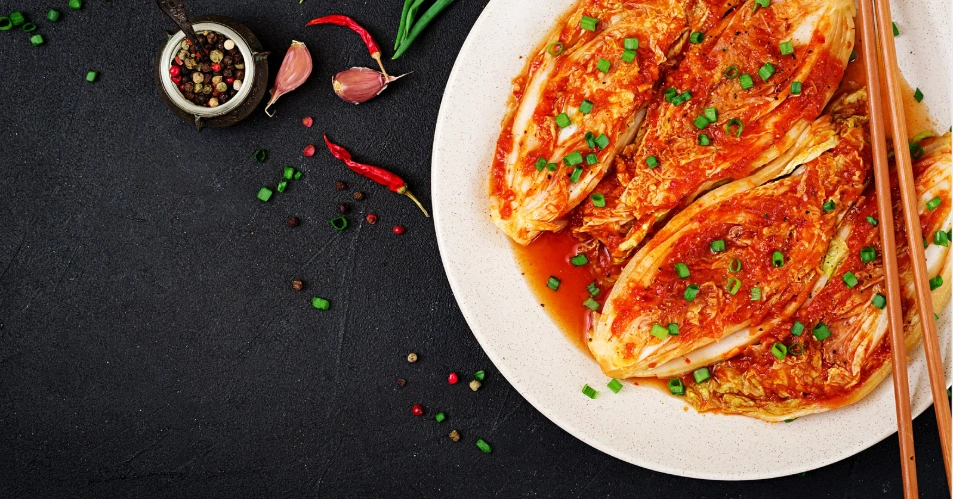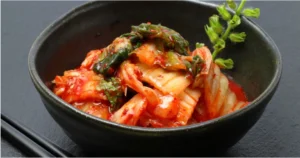
Table of Contents
Kimchi is one of Korea’s most famous culinary treasures, celebrated for its bold flavors, nutritional benefits, and cultural significance. Known for its unique combination of spicy, sour, and umami flavors, kimchi has become a global favorite. Let’s explore its origins, ingredients, preparation methods, and variations in detail.
What is Kimchi?
Kimchi is a traditional Korean dish made from fermented vegetables, most commonly napa cabbage and Korean radishes. It’s seasoned with a mix of gochugaru (Korean chili powder), garlic, ginger, fish sauce, and other spices. Kimchi is not only a staple in Korean households but also a key representation of Korea’s cultural heritage.
Key Features of Kimchi:
- Fermented: Kimchi undergoes a natural fermentation process that develops its signature tangy flavor.
- Versatile: It can be eaten as a side dish, an ingredient in main dishes, or even as a snack.
- Healthy: Kimchi is rich in probiotics, vitamins, and antioxidants, promoting gut health and overall well-being.
Key Ingredients for Kimchi
Below is a table of essential ingredients for making traditional napa cabbage kimchi:
| Ingredient | Quantity | Purpose |
|---|---|---|
| Napa cabbage | 2 heads | Base ingredient for traditional kimchi |
| Korean radish | 1 large | Adds crunch and flavor |
| Coarse sea salt | 1 cup | Used for salting the cabbage |
| Gochugaru (chili powder) | 1/2 cup | Provides heat and color |
| Garlic | 10 cloves | Adds aromatic depth |
| Ginger | 1 thumb-sized piece | Enhances flavor |
| Fish sauce | 2-3 tablespoons | Traditional umami seasoning |
| Sugar | 1 tablespoon | Balances the spice and sourness |
| Green onions | 5-6 stalks | Adds fresh, mild onion flavor |
How to Prepare Kimchi: Step-by-Step Recipe

1. Salt the Cabbage
- Cut the napa cabbage into quarters and remove the core.
- Rinse the leaves and generously coat them with coarse sea salt.
- Leave the cabbage to brine for 2-3 hours, turning occasionally. This draws out moisture and softens the leaves.
- Rinse the salted cabbage thoroughly and drain well.
2. Prepare the Kimchi Paste
- In a bowl, mix gochugaru, minced garlic, grated ginger, fish sauce, and sugar.
- Add a small amount of water to form a thick paste.
3. Mix with Vegetables
- Slice the radish into matchsticks and chop the green onions.
- Combine these vegetables with the kimchi paste, ensuring even coating.
4. Apply the Paste to the Cabbage
- Carefully spread the kimchi paste between each leaf of the salted cabbage quarters.
- Ensure even distribution for optimal flavor.
5. Fermentation
- Place the coated cabbage into an airtight container or traditional kimchi jar.
- Press down firmly to remove air pockets.
- Leave the container at room temperature for 1-2 days to kickstart fermentation, then transfer it to the refrigerator.
- Kimchi is typically ready to eat within a week but develops more flavor over time.
Tips for Perfect Kimchi
- Use Fresh Ingredients: Fresh vegetables and high-quality gochugaru make a noticeable difference in flavor.
- Maintain Cleanliness: Always use clean tools and containers to avoid contamination.
- Adjust Spice Levels: Tailor the amount of gochugaru to your spice tolerance.
- Ferment Properly: Monitor the fermentation process to achieve your preferred level of tanginess.
Variations of Kimchi
Kimchi comes in many forms, varying by region and ingredients. Here are some popular variations:
- Baechu Kimchi: The classic napa cabbage kimchi.
- Kkakdugi: Diced radish kimchi, known for its crunchiness.
- Oi Sobagi: Stuffed cucumber kimchi, often enjoyed in summer.
- Mul Kimchi: Water-based kimchi with a milder, refreshing taste.
- Chonggak Kimchi: Made with young radish greens.
- Vegan Kimchi: Prepared without fish sauce, using soy sauce or miso for umami.
Nutritional Benefits: Proteins or Carbohydrates?
Kimchi is a nutrient-rich food that offers both proteins and carbohydrates in small amounts:
- Carbohydrates: Comes primarily from the vegetables and a small amount of sugar.
- Proteins: Minimal, but present in the form of enzymes and amino acids from fermentation and fish sauce.
- Probiotics: Supports gut health due to beneficial bacteria formed during fermentation.
- Vitamins and Minerals: High in vitamins A, B, and C, as well as calcium and iron.
FAQ Section
What is kimchi made of?
Kimchi is made from vegetables like napa cabbage or radish, seasoned with chili powder, garlic, ginger, and fish sauce.
Is kimchi spicy?
Kimchi is typically spicy, but the heat level can be adjusted based on the amount of gochugaru used.
How long does kimchi last?
Properly stored kimchi can last for several months in the refrigerator, developing deeper flavors over time.
Is kimchi vegan?
Traditional kimchi contains fish sauce, but vegan versions use soy sauce or miso as substitutes.
Can I use table salt instead of sea salt?
It’s best to use coarse sea salt, as it draws out moisture without over-salting.
Conclusion
Kimchi is not just a dish; it’s a cultural icon that embodies the flavors and traditions of Korea. With its tangy taste, health benefits, and endless variations, kimchi has secured its place on dining tables worldwide. Follow this guide to create your own batch of authentic kimchi and savor the taste of Korea at home.
For more exciting recipes and culinary tips, subscribe to our newsletter and embark on a flavorful journey through global cuisines. Enjoy your kimchi-making adventure!
how to make kimchi paste at home. how to make kimchi filipino style. how to make kimchi cucumber
when you try the meal, give us your opinion
reviews
There are no reviews yet. Be the first one to write one.
